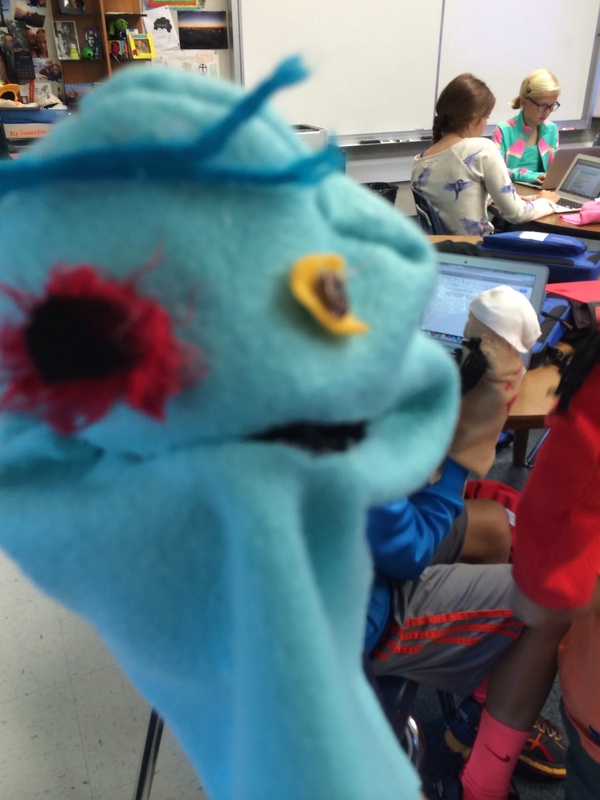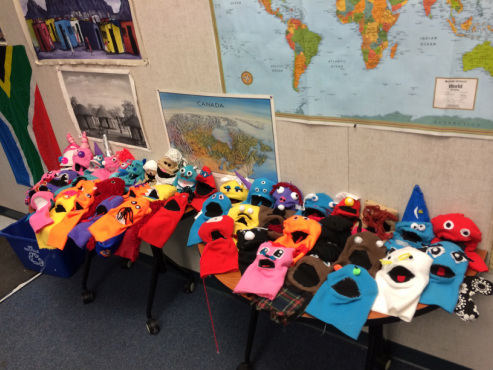Frankly, the vast majority of the puppets I've made have been hand-sewn, including my favourite one: Frostie (seen here wrestling with my cat).
And last year, I made sock puppets with all of my students and that ended being a really fun day, but a huge mess, a waste of materials, and puppets that they never really used.
There had to be a better way.
The next challenge was how to teach all of my 6th graders to make these small puppets. The process took about two weeks, with about 20-30 minutes of each class period (I have them for 90-120 minutes every day, so that isn't a significant portion of each class period).
We started by drawing designs. I showed them the basic shape they'd be working with, and asked them to draw a sketch that included colours, shape and details.
That night, I counted how many wanted what colour and I cut out the puppet pelts. I cut them into one foot squares. That means you can get nine pelts out of one yard of anti-pill fleece. With a teacher discount and a great sale, that meant I needed just under six yards (for fifty students) and it cost about $15.
The next few days were devoted to sewing up the back seam and shaping the head. Here's the video I used to teach them this process.
After they shaped the head and sewed the seams, we made the mouth. I gave them a choice of cardboard from a box, cardboard from a box of granola bars, or file folders. I showed them how the thinner the mouth, the wider range of expression. And the more durable the mouth, the less chance there is that you'll have to do a mouth-ectomy at some point in the puppet's life.
From there, I had them make finger and thumb tape loops, and then gave them a choice of white or black felt to cover the mouth.
I learned last year that if you leave materials out, students will typically A) take way more than they need, B) end up throwing away the waste, and C) make a huge mess. Since I was funding this entire process, I decided that if they wanted felt or pompoms or yarn or pipecleaners, they had to go through me. I set up on the back counter so I could also see the entire room.
Being the Keeper of the Felt also allowed me to ask a very important question every time a student came back to get mouth felt: "Did you watch the video?" If the answer was no, they were sent back to watch it on their laptops. If they said yes I would quiz them a little bit and then give them the felt and send them off to sign up for the hot glue station.
The hot glue gun list was actually a student idea. They grew frustrated when people would shove in and take a turn instead of waiting in the line. So the students created a hot glue gun list that helped tremendously. I only wanted six hot glue guns running at once because it forced them to work together, and it was the only practical way to do it in a room with outlets only on two of the walls.
And here's where the Great Divide happened.
The students who watched the videos cut the mouth hole in a straight line and were much more successful at getting a good shape on the face and a mouth that worked well.
The other students who either pretended to watch the video or just didn't understand it, cut a circular hole. As my friend Sam says, most of your puppeting mistakes will be with scissors. And you can't fix mistakes with scissors easily.
Here is one such mistake with scissors.
So after the mouth was attached, I had them work on the eyes. I showed them the puppets I had made and the various eye styles they could try.
So students made their choices and glued them onto their puppet. They made accessories and outfits and hats.
When students finished their puppet, I took their puppet sketch and loaded them into Aurasma. I had them make a short video describing the process they went through making their puppet. Here are some of them (if you have Aurasma, these are all triggers).
Well, except for a few. After the first 7-8 days of work, there were puppets that still weren't sewn properly (shockingly, putting four stitches up the whole back does not hold!). Some had made circle mouths that were barely glued in. It was clear we needed a Puppet Emergency list.
I found the puppets that needed some work and did a little coaching with their creators. If the student had just been rushed or haphazard but was capable of fixing the mistake, I pushed them to do so. However, for the students who really struggled with the process and genuinely needed more help, I did the work while they watched.
One of those puppets was the blue puppet pictured above. He needed an entire mouthectomy. He also had lots of hot glue spots from accessories his creator attached and then removed. So I pulled out the mouth and all the hot glue and started over attaching them together.
Here's the pile of hot glue I took off of the puppet.
Students don't always know what they need. That's why teachers will never be irrelevant, even in a flipped classroom (as many detractors claim). My videos worked for about 90% of the students. But another 5% needed me to show them and guide their hands as they completed the process. And the remaining 5% needed me to help them, but didn't even know it. If I hadn't checked their work carefully, they would have continued with bad designs that would have fallen apart eventually.
Our students need us, whether we're making puppets, learning to write, or solve complex word problems. They need us to listen, to guide, to let them run ahead, and even to let them fall. They have to make mistakes. They have to try and fix them on their own. But as teachers, we need to make sure we are listening to our students and seeing their needs better than they can.
We often say that puppets are magic, and this is one more way in which they're magic: they told me pretty quickly which students would need more feedback and guidance, and which students needed to learn to pick themselves up when they fell. Knowing that in the first few weeks is definitely magic in my book.








 RSS Feed
RSS Feed
